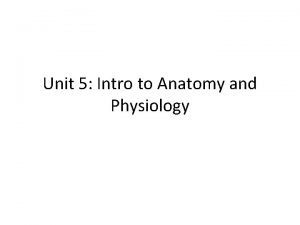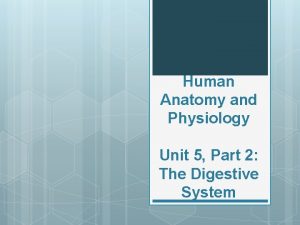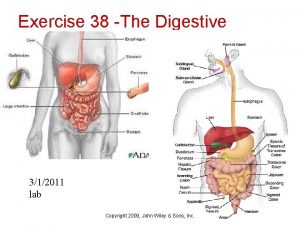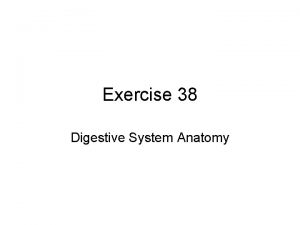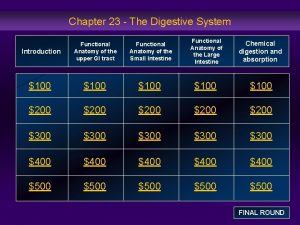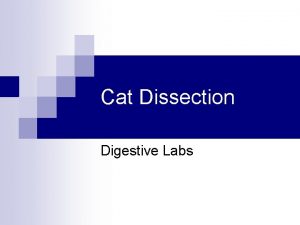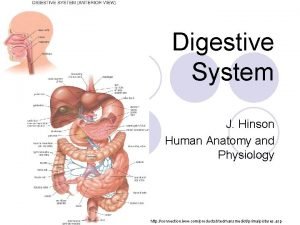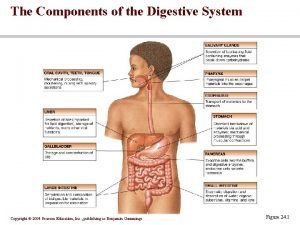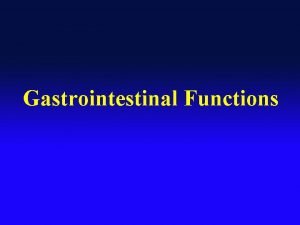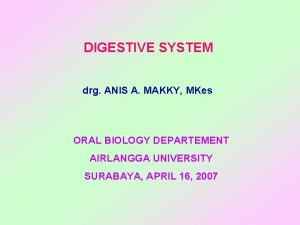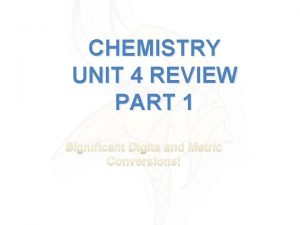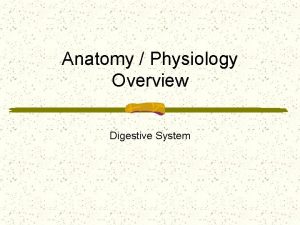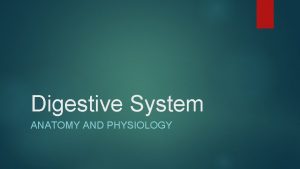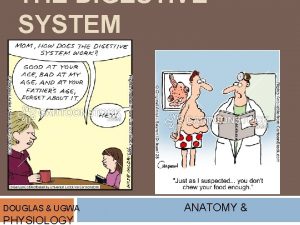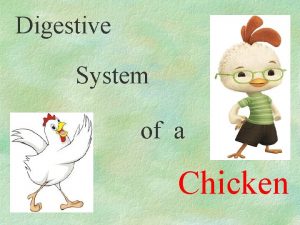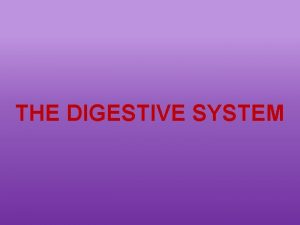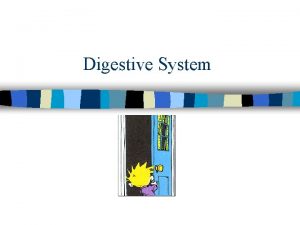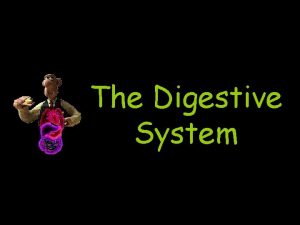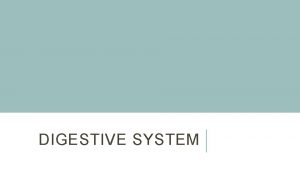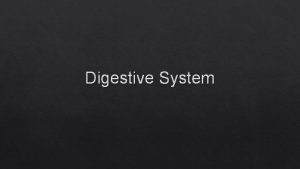Digestive System Honors Anatomy Physiology Unit 6 A













































- Slides: 45

Digestive System Honors Anatomy & Physiology

Unit 6 A Learning Objectives 6. 1 Name & identify the organs of the alimentary canal and accessory organs of digestive system, including wall of alimentary canal and the peritoneum 6. 2 Identify overall function of digestive system and describe how each organ assists this function 6. 3 Describe the 6 digestive processes required for the digestive system to function properly 6. 4 Describe the composition and function of digestive secretions: saliva, pancreatic juices, bile, pepsin, HCl 6. 5 Explain the anatomy of villi and their role in absorption of nutrients 6. 6 Describe the mechanisms of swallowing, vomiting and defecation 6. 7 Describe what happens to foodstuffs as they move along the GI tract 6. 8 Differentiate between how proteins, fats and carbohydrates are digested -where and how 6. 9 Identify some common ailments of the digestive system

Function & Organization Function • The breakdown of food into small enough particles to be digested and absorbed Organization • Alimentary Canal aka GI tract • Accessory Organs

Digestive Processes • Ingestion: bringing food into the system • Mechanical Digestion: the mechanical breakdown of food (chewing, mixing, churning) • Propulsion: movement of food through system

Digestive Processes • Chemical Digestion: breakdown of large food molecules by enzymes • Absorption: transport of digested food materials to the blood or lymph • Defecation: elimination of indigestible material from the body

Peritoneum • The largest serous membrane of the body, lining all organs of the abdominal cavity and the cavity wall – Parietal peritoneum: lines walls – Visceral peritoneum: lines organs – Peritoneal cavity: potential space between membranes; produces serous fluid

Extensions of the Peritoneum • Falciform ligament: connects liver to anterior abdominal wall and diaphragm • Lesser omentum: attaches to medial stomach, attaching it to anterior wall

Extensions of the Peritoneum • Greater Omentum: extends off stomach; contains lymph nodes and holds fatty deposits • Mesentary: suspends coils of small intestine and attaches it to posterior abdominal wall

http: //www. nvcc. edu/home/lmiller/atlas/Digestive%20 System/mesentary 2. gif

Wall Structure of Alimentary Canal • 4 layers – Mucosa/mucus membrane – Submucosa – Muscularis – Serosa http: //www. lab. anhb. uwa. edu. au/mb 140/Core. Pages/Oral/Images/gitplan. gif

Wall Structure of Alimentary Canal 1. Mucosa: lines lumen of alimentary canal – Protects us from microorganisms – Absorbs digested food materials – Secretes mucous & digestive enzymes

Wall Structure of Alimentary Canal 2. Submucosa -Rich in blood vessels, lymphatic vessels and nerve endings -Provides nourishment for tissues and carries away absorbed materials

Wall Structure of Alimentary Canal 3. Muscularis: smooth muscular layer • Induces a propelling action called peristalsis • Has 2 parts: – – Inner layer runs longitudinally Outer layer (constrictor layer) runs circularly

Wall Structure of Alimentary Canal 4. Serosa - Visceral peritoneum -Outermost covering of alimentary canal

Alimentary Canal: Mouth o Function: receives food, starts digestion and prepares it for swallowing - Teeth: performs mastication (chewing) - Uvula: fingerlike extension from archway; works with soft palate to close opening to nasal cavity upon swallowing http: //meltingmama. typepad. com/photos/uncategorized/20 08/01/03/mouth_uvula. gif

Swallowing • Aka deglutition: occurs in 2 phases • Requires coordination from tongue, soft palate, pharynx and esophagus • 1. Buccal phase: food mixed with saliva to form bolus---forced into pharynx by tongue • 2. Pharyngeal-esophageal phase: involuntary, controlled by vagus nerve – Tongue blocks mouth, uvula of soft palate blocks nasal passage, larynx closed by epiglottis so food forced down esophagus

Mouth continued o Salivary Glands: accessory organs around mouth; secretes saliva - saliva: 99. 5% water, 0. 5% solutes - Lysozome: destroys bacteria - Salivary amylase: begins chemical digestion of carbohydrates - Mucus: lubricates and binds food particles to form a bolus

Alimentary Canal: Pharynx o Function: transports food from oral cavity to esophagus -uvula and epiglottis assist pharynx in transporting bolus to the esophagus ONLY

Alimentary Canal: Esophagus Function: 10 inch muscular tube that transports bolus to stomach from pharynx - Peristalsis: alternate waves of muscle contraction & relaxation; moves bolus along alimentary canal

Esophagus continued - Mucosa: made of stratified squamous epithelium to resist abrasion - Cardio-esophageal sphincter: found at distal end; acts as a valve to prevent stomach contents from entering esophagus Sphincter: a circular muscle; acts as valve between organs

Vomiting • Aka emesis • Controlled by emetic center in brain (medulla) • Reverse peristalsis occurring in stomach or small intestine along with contraction of abdominal wall and diaphragm (increases internal pressure) • Causes: irritation of stomach (toxin); disturbance of equilibrium in inner ear

Alimentary Canal: Stomach o Function: c-shaped organ acting as a temporary storage site for food; performs mechanical and chemical digestion -Rugae: deep folds formed by inner lining of stomach when empty -Full stomach: can hold up to 1 gallon of food

Stomach continued o Divided into 4 regions: 1. cardia: receives bolus from -esophagus 2. fundus: expanded region, temporarily holding food

Stomach continued 3. body: main part of stomach - greater curvature: convex lateral margin -lesser curvature: concave medial margin 4. pyloris: inferior region with thickened walls -pyloric sphincter: valve that controls movement of food from stomach into small intestine

Stomach Wall • 4 basic layers: mucosa, submucosa, muscularis and serosa • Mucosa & muscularis is functionally and structurally different – Mucosa: gastric pits work to produce and secrete gastric juices • HCL, digestive enzymes and mucus

Stomach Wall – Muscularis • Stomach has an additional layer of muscle fibers • Allows stomach to churn and mix stomach contents

Stomach Functions • Mechanical Digestion: churning and mixing of stomach contents to aid digestion • Chemical Digestion: pepsin: breaks down proteins (works only in acidic environments-HCl in stomach!)

Stomach Functions • Absorption: limited absorptive abilities (water, salts, glucose, alcohol, aspirin and some lipid-soluble drugs) • Propulsion: propels food into small intestine in the form of CHYME (mixture of food particles & gastric juice) – Chyme presses against pyloric sphincter causing it to relax and allows chyme to pass

Carbohydrate Digestion • Carbohydrate: nutrient; main source of energy in the body – Glucose: a simple sugar; the end product of carbohydrate digestion • Takes place in the mouth & small intestine • Enzymes: – salivary amylase: starch to double sugars – pancreatic enzymes, intestinal enzymes (maltase, sucrase, lactase): double sugars to simple sugars

Protein Digestion • Protein: basic nutrient; used in anabolism (tissue building) – Amino Acid: the building blocks of proteins; the end product of protein digestion • Takes place in the stomach & small intestine • Enzymes: – Pepsin in gastric juices – Trypsin in pancreatic juice – Peptidases in intestinal juice

Fat Digestion • Basic food type; used for energy and insulation – Fatty acids and glycerol: end products of fat digestion • Takes place in the small intestine • Enzymes: – Bile in duodenum: fat droplets into smaller fat droplets – Pancreatic lipase: small fat molecules into fatty acids and glycerol

Time to Digest • Carbohydrate-rich meal: moves through the stomach rapidly • Fat-rich meals: may take up to 6 hours to pass through the stomach

Alimentary Canal: Small Intestine • Completes mechanical and chemical digestion & is the main site of nutrient absorption • Propels food through with peristaltic waves • 20 feet long, highly coiled • Takes ~ 3 -10 hours to move chyme through • Suspended to posterior abdominal wall via mesentary

Small Intestine continued 3 Segments: 1. Duodenum: receives chyme from stomach & digestive enzymes from accessory organs; about 10 inches long 2. Jejunum: site of absorption; about 8 feet long

Small Intestine continued 3. Ileum: about 12 feet long; the end of digestion and absorption of nutrients Ileocecal valve: the junction at which the small & large intestine join; sphincter muscle controlling the flow of material between organs

Wall of Small Intestine • Highly convoluted mucosa for better absorption through increased surface area – Intestinal villi: tiny projections of mucosa – Microvilli: even smaller projections on the intestinal villi

http: //www. biog 1105 -1106. org/demos/105/unit 6/media/villus. structure. jpg

Wall of Small Intestine • Within each villi is: – Blood capillaries – Lacteals (lymphatic vessels) - Act to carry absorbed nutrients away

Alimentary Canal: Large Intestine • Final segment of alimentary canal • ~5 feet long but larger in diameter than small intestine • Function: to dry out indigestible material by absorbing water; eliminate unwanted materials

Large Intestine continued • 5 main segments of large intestine – Cecum: sac-like pouch receiving material from ileum – Vermiform appendix: worm-like extension holding lymphatic tissue – Colon: ascending, transverse, descending, sigmoid – Rectum – Anus

Large Intestine continued Anus: has 2 sphincters 1. Internal: involuntary; told to relax when fecal matter stimulates the defecation reflex in the rectum 2. External: voluntary; if relaxed, elimination occurs

Fecal Formation • Fecal matter: 75% water, 25% indigestible material, mucus and bacteria – Color: produced by bile – Gas: produced by the metabolism of bacteria or from swallowing air – Movement of matter is very slow ~ 1824 hours

Mass Movement & Defecation • Food residue moves through large intestine via peristalsis and mass movement • Mass movements: slow moving powerful contractile waves over colon – Occurs 3 -4 X per day (oftentimes just after eating) • Defecation Reflex: feces stretching out rectum walls which contract while sphincters relax – Communication between rectum and brain to decide if “now is the time”

Digestion Mishaps • Heartburn: the damage to esophageal mucosa due to presence of stomach acids because of a weak cardio-esophageal sphincter • Gastric ulcer: when the mucus layer of the stomach is not strong enough to withstand gastric acids; burns a hole in stomach wall

Digestion Mishaps • Diarrhea: the decreased absorption of water and electrolytes in the small & large intestine leading to watery stool • Constipation: the increased absorption of water and electrolytes in the large intestine; leads to hard, impacted stool
 Anatomy and physiology unit 7 cardiovascular system
Anatomy and physiology unit 7 cardiovascular system Teks anatomy and physiology
Teks anatomy and physiology Unit 26 animal anatomy physiology and nutrition
Unit 26 animal anatomy physiology and nutrition Long axis of body
Long axis of body Esophagus wall
Esophagus wall Respiration
Respiration Pectoral girdle acetabulum
Pectoral girdle acetabulum Copyright
Copyright Duodenum
Duodenum Functional anatomy of the digestive system
Functional anatomy of the digestive system Cat digestive
Cat digestive Anatomy digestive system
Anatomy digestive system Intestine
Intestine Protein absorption
Protein absorption Parasimpathetic
Parasimpathetic Digestive system circulatory system and respiratory system
Digestive system circulatory system and respiratory system Honors biology unit 4 test
Honors biology unit 4 test Chemistry unit 4 review answer key
Chemistry unit 4 review answer key English 2 honors vocabulary unit 1
English 2 honors vocabulary unit 1 Pulmonary ventilation
Pulmonary ventilation Tattoo anatomy and physiology
Tattoo anatomy and physiology Anatomy science olympiad
Anatomy science olympiad External parts of a leaf
External parts of a leaf Bone anatomy and physiology
Bone anatomy and physiology Duodenal ulcer anatomy
Duodenal ulcer anatomy Liver physiology and anatomy
Liver physiology and anatomy Difference between anatomy and physiology
Difference between anatomy and physiology Wpigastric region
Wpigastric region Anatomy and physiology of rbc
Anatomy and physiology of rbc The central sulcus divides which two lobes? (figure 14-13)
The central sulcus divides which two lobes? (figure 14-13) Human anatomy and physiology seventh edition marieb
Human anatomy and physiology seventh edition marieb Http://anatomy and physiology
Http://anatomy and physiology Chapter 1 introduction to human anatomy and physiology
Chapter 1 introduction to human anatomy and physiology Physiology of appendix
Physiology of appendix Aohs foundations of anatomy and physiology 1
Aohs foundations of anatomy and physiology 1 Aohs foundations of anatomy and physiology 2
Aohs foundations of anatomy and physiology 2 Anatomy and physiology of swine
Anatomy and physiology of swine Anatomy and physiology chapter 8 special senses
Anatomy and physiology chapter 8 special senses Chapter 13 anatomy and physiology of pregnancy
Chapter 13 anatomy and physiology of pregnancy Science olympiad forensics cheat sheet
Science olympiad forensics cheat sheet Anatomy and physiology chapter 2
Anatomy and physiology chapter 2 Stomach anatomy and physiology ppt
Stomach anatomy and physiology ppt Anatomy and physiology of diabetes
Anatomy and physiology of diabetes Heat and cold
Heat and cold Anatomy and physiology coloring workbook chapter 14
Anatomy and physiology coloring workbook chapter 14 Chapter 10 blood anatomy and physiology
Chapter 10 blood anatomy and physiology



